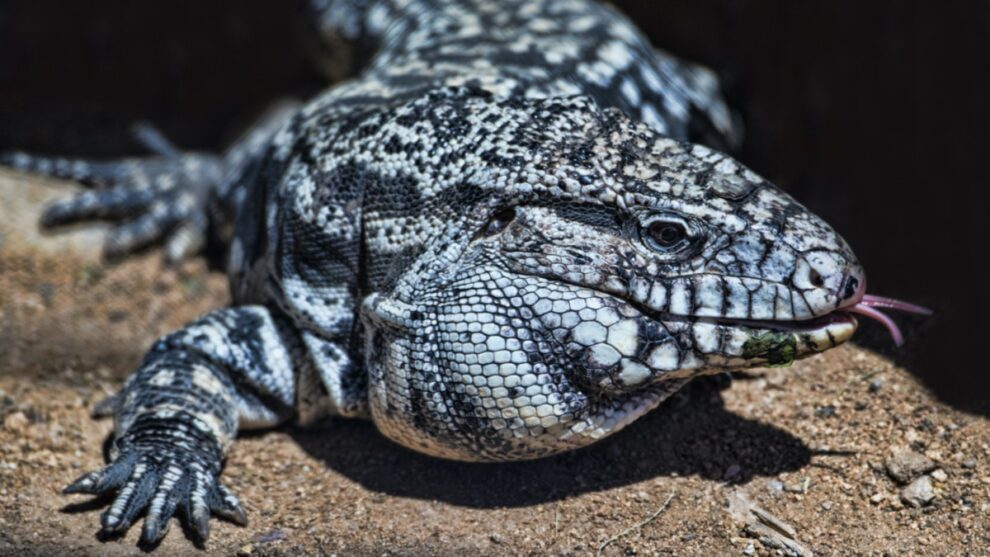Deep in the Everglades, a voracious reptile with attractive spotted scales is among one of the state’s most worrisome invasive species. The Argentine black-and-white tegu, a large lizard that can grow up to four feet in length, has already proliferated widely throughout South Florida. It’s also popped up throughout the southeastern U.S., posing a potential threat to native species and farmers.
The creatures, native to South America, are omnivorous, eating just about anything with nutritional value they can fit in their mouth. They’ll chomp on the eggs of ground-nesting animals such as birds and reptiles, including endangered sea turtles. They’ll snack on doves and other small animals. They’ll snag strawberries and other fruits and vegetables that grow low to the ground.
And they’re extremely hardy, making their spread difficult to control or reduce once the species becomes established. However, recent efforts to limit the animals’ population in the Everglades and Georgia seem to be effective.
While tegus have been breeding in South Florida for more than a decade—after escaping captivity or being released by pet owners—they’ve spread to at least two counties in Georgia in recent years.
The reptiles have also been spotted in four counties in South Carolina, where biologists suspect they may be reproducing. In response, the state enacted a ban against pet-ownership of the reptile in 2021. In 2022, Georgia passed a law regulating—but not outright banning—tegu ownership. There have also been isolated reports of their presence in Alabama, Louisiana, and Texas, as well as established populations in Central Florida.
For those who like to keep exotic animals, intelligent and docile tegus make for sought-after pets. Most in the U.S. are the product of American breeders, but between 2000 and 2010 alone, more than 79,000 live tegus were imported from South America, says Amy Yackel Adams, a biologist with the U.S. Geological Survey studying the animal. While only a tiny minority of the animals escape or are released, biologists believe the problem is worsening.
If many more animals are released, “there is the potential for a very large population in the wild,” Adams says.
A 2018 study conducted by the USGS used information about tegus in South America to predict their possible expansion in the U.S. According to Adams, “the entire southeast portion of the United States is at risk. Much of this area has a climate that is suitable for tegus.” As of yet, there are no official estimates of how many tegus live in the U.S.
Tegus do best in upland forests and grasslands, especially in areas that receive substantial seasonal rain, such as Florida’s hardwood and subtropical pine forests. As climate change causes tropical and subtropical climatological zones to shift north, the range suitable for tegus in North America may also widen, Adams says.
Researchers are most concerned about tegus’ predatory, egg-eating habits. In Venezuela, they’re known for sneaking into chicken coops to steal eggs, earning them the name el lobo pollero, “the chicken wolf.” U.S. poultry farmers should be on guard.
If tegus continue to disperse across the Southeast, Adams says, they could threaten many animals that nest or live on the ground, including the eastern indigo snake, which is listed as threatened under the Endangered Species Act. Adams also worries that they might eat the eggs of gopher turtles—another threatened species—American alligators, American crocodiles, and more.
Can they be stopped?
Tegus are hardy, able to withstand colder temperatures than some other reptiles because they can elevate their body temperature as much as 18 degrees Fahrenheit above the ambient temperature. If it gets too frigid in winter, they can brumate, the reptile version of hibernation, becoming sluggish and hiding out in burrows they’ve stolen from gopher tortoises or other burrowing animals.
They can recover quickly from threats, such as hunting. “In the 1980s, the tegu was the most exploited reptile in the world,” says Lee Fitzgerald, a professor of zoology at Texas A&M University. During that time, some two million tegu skins were exported from Argentina each year for the leather trade. “Yet nowhere were they hunted to local extirpation,” Fitzgerald says.
To curb tegus’ entrenchments and further spread in the U.S., wildlife officials and others in states where tegus have taken hold are searching for solutions. (Read why Florida has an invasive species problem.)
In 2020 alone in South Florida, traps set by the USGS captured more than 900 tegus near Everglades National Park. According to the agency’s data, efforts to remove the animals from managed areas are starting to bear fruit: Abundance of the core Everglades population of tegus has seen a slow but steady decrease. Biologists hope to replicate these effective strategies elsewhere.
In Georgia, state biologists have been working to trap tegus in Toombs and Tattnall Counties, west of Savannah, and report that they’re finding fewer of the animals. Daniel Sollenberger, a herpetologist with the Georgia Department of Natural Resources, says the state may have caught the tegu problem in time.
“We’ve been trapping them for a couple of years now,” Sollenberger says. “We brought in around a dozen last year and about a half a dozen this year. It could be that there are fewer of them now, at least in that location.”
Finding new homes for tegus
Part of the solution in Georgia has been to engage state residents in awareness campaigns, encouraging them to report tegu sightings. The Georgia Reptile Society has a Tegu Task Force, in which residents can submit photos of suspected tegus for identification. Once they identify a tegu, the society’s volunteers trap the animal and bring it to a rescue facility. They are then given to people who want them as pets.
“We have indeed seen an increase in surrenders of Argentine black and white tegus,” says Daniel Wolst, vice president of the society. He attributes this uptick to the 2022 Georgia law that require licensing and microchipping of all captive tegus, rather than from an increase in wild tegu populations. (Read why people are so taken with exotic pets.)
“We do everything we can to get the animal, capture it, and try to rehome it,” says Justyne Lobello, former president of the Georgia Reptile Society.
“We want to help take them out of the habitat as humanely as possible. It helps that we have a long waiting list of people who want one as a pet.”
Nonetheless, the best way to fix the problem is by preventing their spread to the wild in the first place, experts say. Some states such as Alabama have enacted laws barring the animal’s import, and others may follow suit. Meanwhile, a few biologists have cautioned against owning these animals at all.
“Tegus are incredible animals which form long bonds with their keepers, and we want to encourage responsible keepers to work with them while also minimizing and, if possible, reversing the damage done by irresponsible keepers,” says Wolst.
“It wouldn’t be honest to say the situation is nearly solved, but organizations like ours and similar private groups, as well as local agencies, are working towards the best solution for all involved.”
Source : National Geographic










